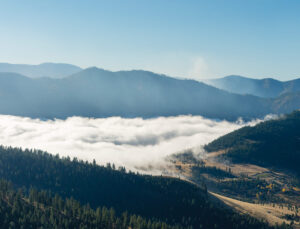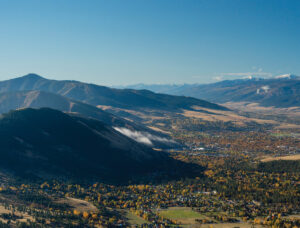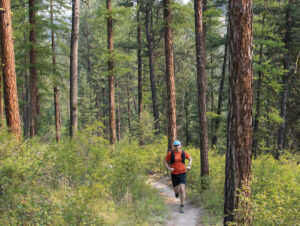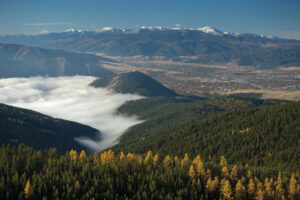
28 Sep The Backyard Ultramarathon
I’d been running and hiking in complete darkness for a couple hours when I disturbed whatever it was in the trees on the ridge between Sheep Mountain and Mount Jumbo, the peaks around Missoula, Montana. Actually, I’d been moving along the trail by myself for more than 15 hours — since 8:10 a.m., and it was now 11:20 p.m. — and I hadn’t seen another person for more than 12 hours, so I was at a point where I could be hearing things that weren’t there.
But this was loud, which made me think that whatever it was, it was pretty large —hopefully not a bear, and if it was a bear, hopefully not a grizzly. I made the excruciatingly difficult decision to bring bear spray in my running vest, which meant I had room for one less bottle of water. But still, it would be really nice to avoid a situation in which I needed to use the bear spray.

Located just four miles north of downtown Missoula, the 61,000-acre Rattlesnake National Recreation Area and Wilderness features over 100 miles of trails throughout the Lolo National Forest.
I’d clearly startled whatever it was, and it crashed through branches and brush about 50 to 60 feet from me for several seconds. I never stopped jogging, just shined my way-too-dim headlamp in its direction, a little worried, but mostly really tired. It went on for a comically long time — the sound of branches snapping, like a slapstick movie scene where a character’s fall keeps going and going, causing more and more destruction as they continue their collapse. I would have laughed, but I really was kind of worried, so I turned my jog into a run, then into as much of a sprint as I could muster. I glanced down at my watch: mile 55.6. My ridiculous day just kept getting more ridiculous, and at this pace, it was going to drag well past midnight and into tomorrow.
Was this my worst idea ever? I mean, everybody does dumb things in life. Ultrarunners though, we do things that are dumb and also take a really long time.
When I moved back to Missoula in July 2020, after 15-plus years of living elsewhere, I was immediately reminded of how accessible the trails are around here, and how big the trail network actually is. When I left, I was more interested in climbing high-alpine peaks; but over the years, I’ve become a trail runner, and now I explore new routes every chance I get. Once here, I became focused on the Rattlesnake National Recreation Area at the edge of town: a 7-mile bike ride from my front door leads to 95 square miles of public land with more than 100 miles of trails.

One afternoon, standing on the summit of Stuart Peak, I looked around and wondered if there might be a way to make a big loop around the whole thing. Back in my apartment that evening, I pulled out the map and found what I thought was the best route, one that traverses the summits of five mountains (Stuart Peak, Mosquito Peak, Mineral Peak, Sheep Mountain, and Mount Jumbo) with only about a mile or so of off-trail travel. I traced it in some mapping software and discovered that it was a hair under 60 miles with about 12,000 feet of elevation gain. I could start at the Cherry Street trailhead — tucked between houses at a dead-end street in Missoula’s Rattlesnake neighborhood — run a few blocks to the Waterworks Hill trailhead, and only touch a few hundred feet of pavement for the rest of the loop. It seemed like a cinch, and also a great way to see a huge swath of beautiful terrain. (Spoiler alert: It was not a cinch. I was correct in that it was a great way to see a huge swath of beautiful terrain, however.)
On October 10, 2020, I parked my car at the Cherry Street trailhead at 8:05 a.m., proud of myself for waking up and starting at least a little bit early. Optimistically and somewhat idiotically, I told my wife, Hilary, that I’d probably be done by 10 p.m. and eating a pizza with her by 10:15 or so.
I started my watch at 8:10 a.m. and jogged a few blocks of sidewalk with the hum of weekday traffic on I-90 just to my left. I had packed my running vest with about 3,500 calories and 3.1 liters of water — a pretty heavy load for jogging — but since it was late in the season, I knew water sources would be a bit scarce. It was 43 degrees and sunny when I started, a little chilly but arguably perfect for all the uphill hiking and jogging I’d be doing in the 18 miles to my first summit, Stuart Peak, which was almost 5,000 feet higher than my car.
In a half-hour, I was on top of Randolph Hill with grassy meadows all around me and the city behind awash in the golden glow of the early autumn morning sun. I tried to remind myself to hike the uphills and only run the downhills in order to keep an all-day pace.
I came into ultrarunning in my late 30s, transitioning from rock climbing and mountaineering, which were my primary motivations to be outdoors in my late 20s and early 30s. I’d climbed all over the West and in parts of Europe, but I started growing weary of the anxiety that went along with it — the fear of making a fatal mistake in the mountains, which is always a possibility when you’re roped up and hanging on a wall with a few dozen — or a few hundred — feet of air underneath you.
When I first started trail running, I hiked uphill sections and ran the flats and downhills, loving the ability to be outside in the mountains all day long without having to worry about so many safety variables. I joked that ultrarunning was all the pain and suffering of mountaineering, without the constant fear of death. Lots of people come into trail running from road running, but I looked at it from more of a mountaineering perspective: I’d spent many long days in the mountains — eight, 12, even 14 hours of moving pretty much nonstop — often while carrying a backpack full of ropes and climbing gear. To me, a 50-kilometer trail run, which is equivalent to 31 miles, would be a similarly long day, but one that simply involved more jogging.
The thing I’ve noticed about ultrarunners — folks who run distances longer than 26.2-mile marathons — is that, aside from the really fast ones at the front of the pack, the rest of us participating in the 31-, 50-, and 100-mile races look pretty normal. We don’t all have 5 percent body fat or look like Ironman triathletes. We’re just regular people with jobs and families and commutes — but perhaps we spend more of our spare time on trails than we do watching Netflix. I can’t speak for other ultrarunners, but for me, the allure boils down to the challenge of picking a goal that might seem impossible (say running 31 miles) and figuring out how to make it possible. And also figuring out how to deal with constant doubt hanging over your head during months of training — and honestly, for me, all the way up until I can see the finish line arch at the end of the race.

Leonard discovered ultrarunning in his late-30s and was drawn to it as a safer — although no less painful or difficult — alternative to mountaineering, which was his main focus in his 20s and early 30s.
It’s a weird hobby, for sure. When I talk to someone who expresses a lack of understanding about why a human being would spend six, or eight, or 30 hours moving nonstop on a trail, I get it. Humans do a lot of weird things for fun nowadays. You may have heard someone ask questions like, “Wait, so you watch videos of other people playing video games?” or “So let me get this straight: You catch the fish, but then you let it go again?” or “Why do you ski uphill when there’s a lift that could take you to the top?” Ultrarunning is just my weird thing.
Or it became my weird thing after I ran my first 50K in 2015; despite the chafing, pain in my legs and feet, and smashed toenails, I caught the bug. I love ultramarathon races — it’s less daunting to push yourself for so many hours physically and mentally when you know the course will be marked and every five or 10 miles there’ll be a table with volunteers to refill your water bottles and hand you Chips Ahoy! cookies. That sort of stuff makes it feel a little less weird.
But in 2020, with many races canceled due to the pandemic, lots of people were designing their own challenges. I picked something close to my home in Missoula. When I looked at the map of my Rattlesnake loop, I saw mileage that I knew was doable. And I considered the challenges: It was close to the city, yet still somewhat remote, meaning if I were to break an ankle, get attacked by a bear, get tired and then lost in a semi-conscious state, or simply be too tired to finish, getting rescued would not be quick or straightforward.
Thus far, I’ve been pretty good at avoiding injury, and ditto for bears. Based on past experience, I’d probably stay together mentally until around the 80-mile mark. And if I became too tired to finish, there was a bailout option at about 35 miles where I could walk 8.2 miles out from Franklin Bridge to the main Rattlesnake trailhead, and getcell service to call Hilary for a ride. The biggest issue was water: The last water source I could see on the map was also at about the 35-mile mark, which meant I’d have to fill up my bottles and then finish the last 25 miles with no more refills.
As I tromped off the summit of Mosquito Peak and down into the basin of alpine lakes below — following the trail as it led down to Rattlesnake Creek — it became obvious that I’d underestimated how long the loop would take. The sun was a little lower in the sky than I’d expected as I approached my bail-out point at mile 35. I was tired and knew I’d bitten off a big chunk that I wasn’t sure I could chew. My two options were: grind out a steep climb of 3,000 feet to the summit of Mineral Peak (and wonder why I didn’t think to bring trekking poles), or jog 8.2 miles out and call Hilary for a ride.
I didn’t want to have to come back and finish it next year, which, knowing myself, is what would happen if I quit. If I wanted to be romantic about it — or dramatic — there was probably some metaphor for life here, but not everything is that poetic. I just wanted to finish. So I turned onto the trail to Mineral Peak, trekked up through dense pine trees in the late afternoon sun, and just kept slogging my way up. With two peaks down and three to go, I hit the summit of Mineral at the apex of the golden hour, just before the sun dropped below the horizon.

Although Leonard’s selfmade route through the Rattlesnake was longer and more demanding than he’d anticipated, he admits it was a great way to explore the backcountry terrain around his new hometown of Missoula.
Jogging through the dark a few hours later, I realized how long it had been since I’d seen another living being. Aside from a couple of deer and the mountain biker at mile 12 or so, I’d been by myself for more than half the day. Never more than 8 miles from downtown Missoula as the crow flies, on foot I was many hours away. And now I was in complete darkness; not even a light from a house or a car was visible.
It was dark, and I was dark too. In the deepest despair I’d felt all day, I was cycling through thoughts about how bad of an idea this whole thing was, how miserable it was, and how it was all my idea, of course, so it was my fault, and who was I going to complain to? Rinse, repeat.
Just before my watch clicked over mile 52, a hint of artificial light appeared over the ridge. Then I saw about a dozen city streetlights, then the overhead lights of I-90, and finally the lights of half the city. I still had a few miles to go, but I could basically see my finish line. Some, but not all, of the doubt dissipated, and my legs moved a little faster with the renewed optimism. Which was good, because in a couple of hours, I’d realize the loop I’d calculated to be 60 miles was, in reality, 65 miles.



No Comments